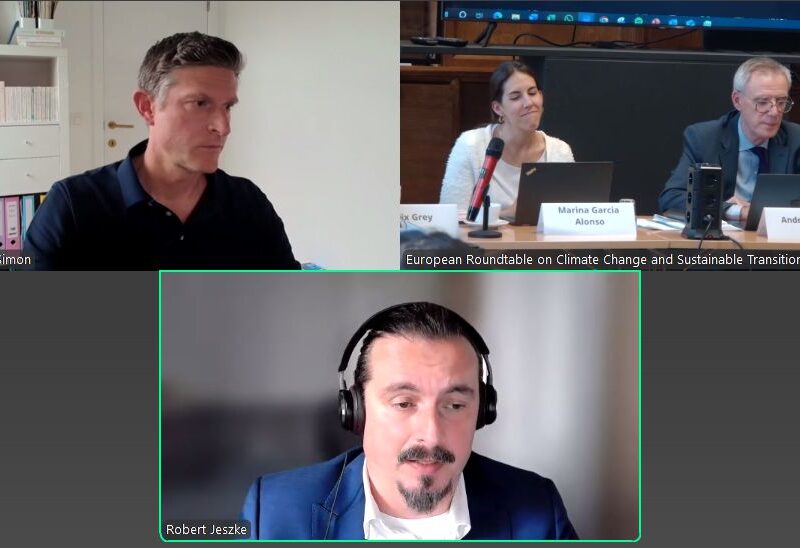
On 27-th of June 2025, at the “Future of Emissions Trading in the EU: Carbon Dioxide Removals” launch event, which was hosted by ERCST in Brussels, Robert Jeszke, Head of The National Centre for Emissions Management (KOBiZE) was invited to speak as one of the panellists.
Robert underlined that the ERCST report explains and captures the key elements currently under discussion, and that now is the right moment to reflect on the integration of Carbon Dioxide Removals (CDRs) into the EUETS – particularly in light of the upcoming 2040 EU climate target and the long-term goal of climateneutrality by 2050.
Robert Jeszke: “We are largely on the same page as ERCST: carbon removals are a necessity. To maintain the EUETS as the right instrument to deliver on the EU’s reduction targets, we need to act now – well ahead of 2040. There will be a shortage of EUA’s, and removals must become part of the solution.“
He also highlighted the following:
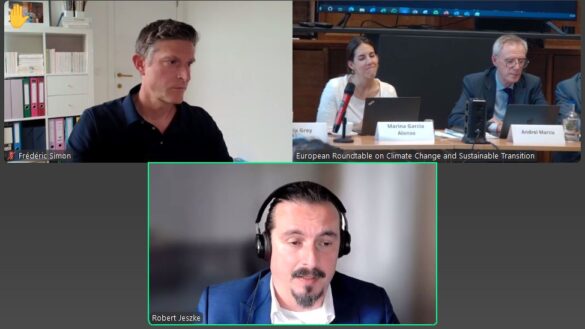
On the 27th June 2025 CAKE/KOBIZE participated in the workshop “LIFE COASE- Workshop on ex-ante assessments of emissions trading” organised by Florence School of Regulation/ European University Institute.
 VIIEW on EU ETS 2050: Linking EU ETS with other carbon pricing mechanisms (3.0 MiB, 263 hits)
VIIEW on EU ETS 2050: Linking EU ETS with other carbon pricing mechanisms (3.0 MiB, 263 hits)
 Policy brief: Introducing the ECCB as the new institution to manage the future EU carbon market (799.8 KiB, 48 hits)
Policy brief: Introducing the ECCB as the new institution to manage the future EU carbon market (799.8 KiB, 48 hits)


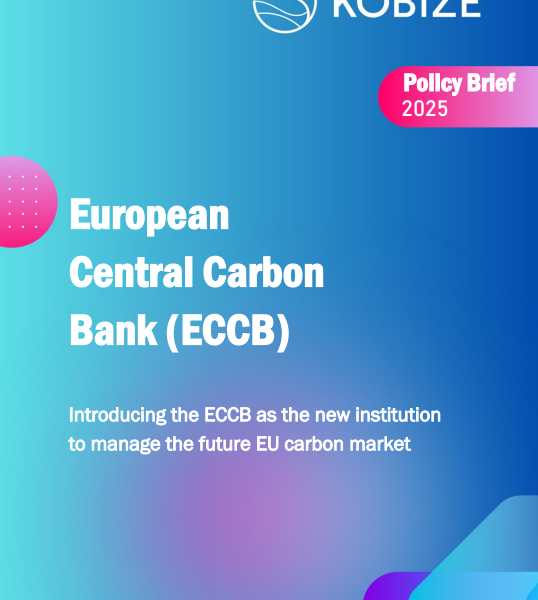
The KOBiZE/CAKE expert team presented new policy brief analysing the concept of establishing the European Central Carbon Bank – an independent institution that would manage the supply of emission allowances (EUAs), carbon dioxide removals (CDRs), and high-quality international offsets under the EU ETS.
 Policy brief: Introducing the ECCB as the new institution to manage the future EU carbon market (799.8 KiB, 48 hits)
Policy brief: Introducing the ECCB as the new institution to manage the future EU carbon market (799.8 KiB, 48 hits)
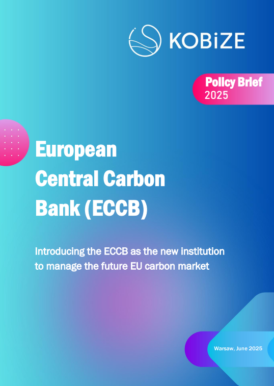 The EU ETS is entering a new phase of evolution: permanent EUA scarcity, political visibility, and integration of complex mechanisms like ETS2, carbon dioxide removals (CDRs), and international offsets. These changes challenge the adequacy of existing institutions and governance tools. In response, the CAKE/KOBiZE team proposes the creation of the European Central Carbon Bank (ECCB) – an independent body modeled after a central bank, designed to stabilize the carbon market and manage supply across an increasingly complex system.
The EU ETS is entering a new phase of evolution: permanent EUA scarcity, political visibility, and integration of complex mechanisms like ETS2, carbon dioxide removals (CDRs), and international offsets. These changes challenge the adequacy of existing institutions and governance tools. In response, the CAKE/KOBiZE team proposes the creation of the European Central Carbon Bank (ECCB) – an independent body modeled after a central bank, designed to stabilize the carbon market and manage supply across an increasingly complex system.
Key features of the ECCB concept:
Recommendations


On the 17 th June 2025 LIFE ENSPIRE webinar on “Carbon Pricing: Challenges for the EU and EU Neighbourhood” was organised by CAKE.
We were delighted to host over 80 participants from Poland, the EU, and neighbouring countries for an in-depth dive into the current challenges and future outlook of climate policy, with a particular focus on carbon pricing, CBAM, MRVA, and cross-border cooperation. The meeting was opened by Marta Rosłaniec (CAKE/KOBIZE) opened he meeting by welcoming the speakers and providing a short brief overview of the LIFE ENSPIRE workshop.
Maciej Pyrka (CAKE/KOBiZE) the LIFE ENSPIRE project coordinator of presented the main goals and scope of the project, which is focused on the carbon pricing. He also presented also the CAKE team and our experiences in climate modelling which were achieved in the previous projects. Finally, he introduced the members of the Advisory Board for the LIFE ENSPIRE project.
Jakub Boratyński (CAKE/KOBiZE) in his presentation provided an analysis of the carbon content and cost estimates for the introduction of the Carbon Border Adjustment Mechanism (CBAM), with projections for 2030 – 2035, based on CAKE’s analysis. Jakub presented the main assumptions for both reference scenario, and the extension scenario. The cost and revenues were presented for Poland, and for the EU. The projected allowance price in EU ETS is 123 EUR in 2030 and 147 EUR in 2035. Please find below a presentation.
Tomasz Karpiński (Energy Community) delivered a presentation on the state of MRVA in the EU neighbouring countries. He also presented the status of the transposition and implementation of the EU ETS directive in several neighbouring countries.
In the second part of the webinar the panel discussion was moderated by our expert Maciej Cygler (CAKE). The core of the discussion centres on the implications and conconsequences of the CBAM for neighbouring countries, as well as the current situation.
Ivan Mrvaljevic (Elektroprivreda Crne Gore, Montenegro) presented resented the latest developments in Montenegro’s preparations for EU accession in the context of the EU ETS and CBAM, with a particular focus on the electricity and energy sectors. It was emphasised that the region is unique and that investment in RES energy and the transmission system is essential. Montenegro has a national EU ETS, and the country is preparing a special plan to implement the full ETS by 2030. Montenegro has expressed its desire to accede to the EU in 2028 or 2029, and is currently engaged in negotiations with the European Commission.
Marie Missao Raude (Florence School of Regulation, European University Institute) provided an overview of the current status of carbon pricing in the EU. Furthermore, the primary elements and objectives of the CBAM were outlined. She also presented several policy changes that are currently under review. These include the 20240 target proposal for emission reduction, the MRS review and the inclusion of carbon removals in the EU ETS. One of the challenges that was highlighted was the impact of the ETS 2 and CBAM changes. She also presented the LIFe COASE project, which is currently managed by the EUI. This provided an excellent opportunity for networking between the two LIFE ENSPIRE and LIFE COASE projects.
Pavlo Masiukov (GIZ, UA) presented a detailed overview of the decarbonisation situation and challenges in Ukraine. He emphasised that Ukraine is a candidate country to the EU and has implemented the Climate Law, which has set a 2050 climate neutrality target. The ETS in Ukraine has been introduced, but its coverage and alignment differ from those of the EU ETS. Therefore, adaptation would be necessary. The MRVA system was introduced in 2021, but was put on hold in 2022 due to the full-scale Russian invasion of Ukraine. It was subsequently reintroduced in 2025, and 500 installations currently provide MRVA reports. There are ongoing developments in the regulations concerning domestic ETS, with the pilot phase scheduled to be implemented in 2028. The final decision on the specific rules for ETS introduction is still under consideration. Ukraine’s challenges in relation to the CBAM are due to the lack of public data that is available due to the ongoing war situation.
The contributions offered fresh insights into how the EU and its neighbours can better align their climate policies and integrate carbon pricing systems more effectively.
Agenda: LIFE ENSPIRE_workshop_agenda_17062025_v3
Presentations:
 LIFE-ENSPIRE_Workshop_Maciej-Pyrka_17062025.pdf (2.1 MiB, 14 hits)
LIFE-ENSPIRE_Workshop_Maciej-Pyrka_17062025.pdf (2.1 MiB, 14 hits)
 LIFE-ENSPIRE_Workshop_CBAM_Jakub-Boratynski_17062025.pdf (1.3 MiB, 13 hits)
LIFE-ENSPIRE_Workshop_CBAM_Jakub-Boratynski_17062025.pdf (1.3 MiB, 13 hits)
 Tomasz Karpiński_State-of-MRVA-in-the-Energy-Community.pdf (1.0 MiB, 11 hits)
Tomasz Karpiński_State-of-MRVA-in-the-Energy-Community.pdf (1.0 MiB, 11 hits)
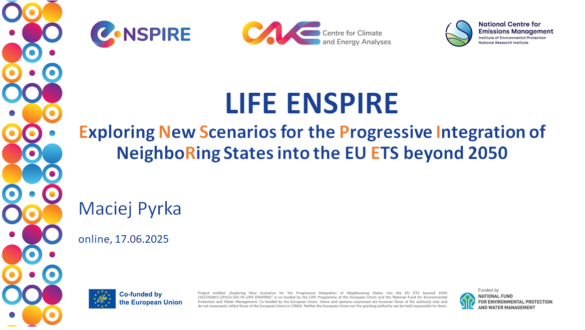
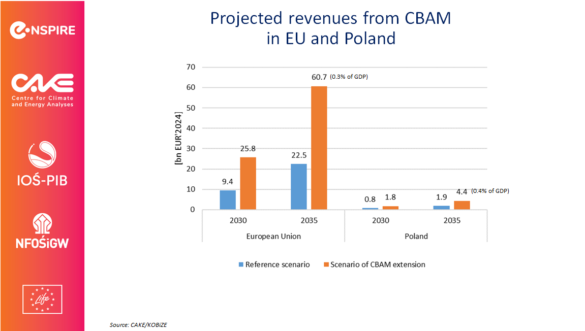
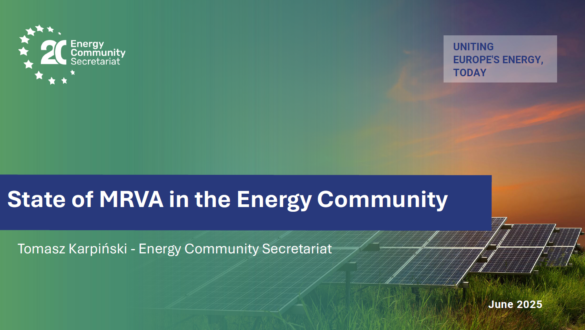

The annual meeting “Energy Community Climate and Energy Reporting under the Adapted Governance Regulation” on climate and energy reporting took place on 3-4 June 2025 at IOŚ-PIB in Warsaw. The conference was organised by the EEA and the Energy Community, and the event was attended by representatives of the EU institutions (DG ENER, DG CLIMA), the Energy Community and delegations from the Western Balkan countries, Ukraine, Moldova.
The main objectives of the meeting included:
Plenary sessions and panels addressed, among others:
The second day of the event was dedicated to group work and discussions on technical improvements and long-term reporting needs. A common conclusion from the deliberations was the need to: